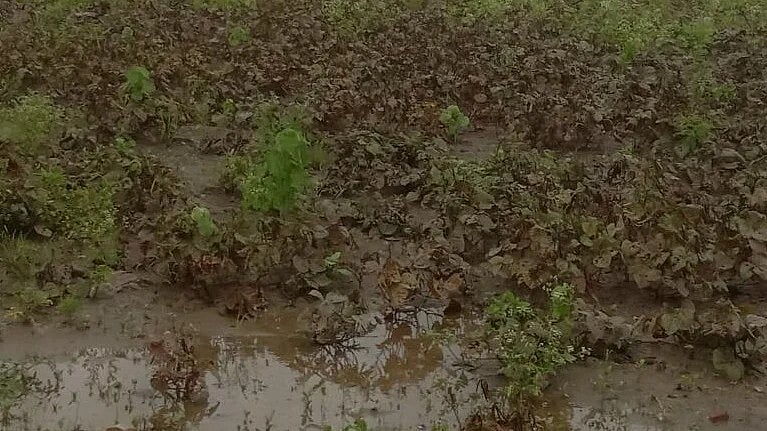
A green gram field in Nargund taluk of Gadag district is waterlogged.
Credit: DH photo
Dharwad: Farmers who sowed pulses such as green gram and black gram during the kharif season are staring at heavy losses due to incessant rains.
According to estimates by the Agriculture Department, pulses grown on nearly four lakh hectares are now under threat of damage. Following early rains in mid-May, farmers in Dharwad, Belagavi, Haveri, Gadag and Bagalkot districts had taken up early sowing. With the crop now ready for harvest, untimely heavy showers have dealt a severe blow.
In Karnataka, green gram has been sown on 23.16 lakh hectares this kharif, of which nearly 70% (18 lakh hectares) is concentrated in central and north Karnataka. This makes it a major crop for districts such as Gadag, Haveri, Dharwad and parts of Belagavi and Bagalkot.
Farmers in over 14 taluks, encouraged by early rains in May, sowed green gram ahead of schedule. However, excessive rainfall in June and July damaged germinating crops across nearly two lakh hectares, forcing many farmers to switch to maize. Now, an additional four lakh hectares of green gram are waterlogged and at risk.
Black gram, sown on 11.46 lakh hectares across the state, including about four lakh hectares in central and north Karnataka, has also been hit. Officials estimate 10–15% of the black gram crop could be damaged.
“Last year too, August rains ruined the harvest and we managed barely 50% yield. The situation is no different this year. Nearly 60% of the crop is standing in water and facing damage,” said Mallikarjun Hiremath, a farmer from Yadwad who has cultivated 20 acres of green gram and black gram.
Farmers in Nargund and Bagalkot raised their voice in protest, saying relentless rains had washed away their crops. They expressed anger at not receiving crop-loss compensation or insurance relief for the past two years.
Basangouda Malipatil, a farmer from Nargund, lamented successive losses.
“The crops were healthy, and we were expecting a bumper harvest. But the August rains destroyed everything. It is harvest time, yet continuous rains are preventing us from even entering the fields,” he said.
Meanwhile, green gram prices have surged in APMCs, touching Rs 9,000 per quintal, with market analysts predicting further escalation if crop damage continues.
Agriculture officials noted that farmers, eyeing a second crop, had deliberately opted for early sowing of green gram this year, making the damage more painful.
In the Dharwad district alone, green gram is cultivated on one lakh hectares, with nearly 60% of farmers opting for early sowing, said Joint Director of Agriculture Manjunath Antharvalli.
“This is a crucial harvest period, but relentless rains have caused great concern,” he said.
Apart from green gram and black gram, soya and maize are also reeling under the threat of rain damage.